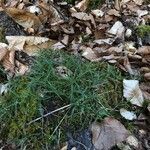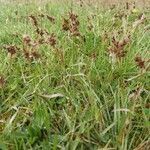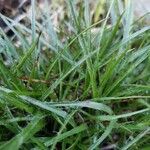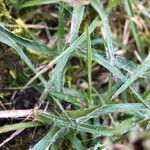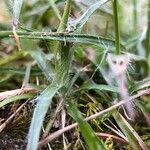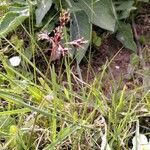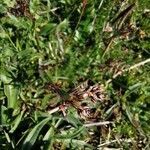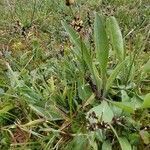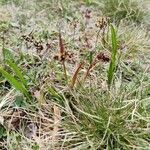Rhizomes conspicuous. Stolons short, slender. Culms not cespitose, decumbent, 10--20 cm. Leaves: basal leaves few, 2.5--15 cm x 4 mm, apex callous, pilose. Inflorescences racemose; glomerules 2--6, central glomerules sessile or all congested, not cylindric; peduncles straight, divergent as much as 90°, to 3 cm; proximal inflorescence bract dark, often purplish, leaflike. Flowers: tepals dark reddish, shining, with wide clear margins and apex, (apex acuminate, midrib extending as awned tip), 3--3.5 mm; outer and inner whorls equal; anthers ca. 2--6 times filament length; stigmas ± equal to style. Capsules brown, shining, (usually lighter than tepals), conspicuously shorter than to nearly equal to tepals; (beak obvious). Seeds reddish, globose, 1--1.3 mm; caruncle to 1/2 seed length. 2n = 12.
Tufted perennial up to 60 cm. high; stolons sometimes present.. Cataphylls present.. Leaves up to 30 cm. long and 6 mm. wide; basal leaves with blunt hardened tips; cauline leaves with acute tips, or blunt and hardened; margins hairy.. Peduncle leafy.. Inflorescence taller than the leaves, compound, branched; flowers in capitula; lower bracts leaf-like, margins hairy; upper bracts scarious, usually not much laciniate; each flower subtended by a bract and 2 bracteoles.. Perianth-segments lanceolate, 2–3 mm. long, pale buff to blackish-purple.. Stamens 6.. Capsule ± ovoid, mucronate.. Seeds 1.2–2.5 mm. long, tailed.
Grass-like, loosely tufted, stoloniferous or rhizomatous. Leaves (1)-2-3 mm wide, < stems, bright green, soft and flaccid, with long silky hairs scattered along margins, tip obtuse. Flowering stems 5-15-(30) cm high, slender, often drooping. Inflorescence of 3-6, few-flowered oblong clusters ± 5 mm diam. on slender drooping peduncles. Flowers 3-3.5 mm long, not close-set, with bases of flowers and rhachis between them visible; tepals very dark brown with brownish membranous margins. Stamens 6; anthers 2-6 times longer than filaments. Capsule < tepals, greenish-brown. Seeds with conspicuous white caruncle.
Plants only loosely cespitose, with short but evident rhizomes or stolons; anthers mostly 1–1.5 mm long and 2–4 times as long as the filament; seed-body globular; 2n=12; otherwise much like no. 5 [Luzula multiflora (Retz.) Lej.]. Native of Europe, casually intr. in disturbed habitats at least in Mass. and perhaps elsewhere.

